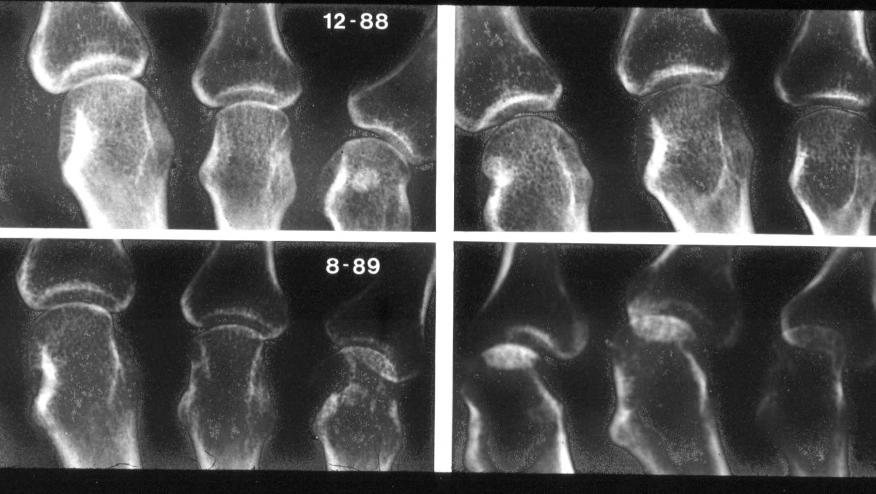Denosumab Protects Against RA Erosions Save

Combining denosumab (Prolia) with a conventional disease-modifying antirheumatic drug (DMARD) such as methotrexate showed promise for slowing radiographic damage in rheumatoid arthritis (RA), a manufacturer-sponsored phase III trial called DESIRABLE found.
At 1 year, patients who were randomized to placebo had a change from baseline in their total Sharp score of 1.49 (95% CI 0.99-1.99), while those who received subcutaneous denosumab, 60 mg every 6 months, had a change of 0.99 (95% CI 0.49-1.49, P=0.0235) and those given that dose of denosumab every 3 months had a change of 0.72 (95% CI 0.41-1.03, P=0.0055), according to Tsutomu Takeuchi, MD, PhD, of Keio University School of Medicine in Tokyo, Japan, and colleagues.
In addition, the proportions of patients with no radiographic changes at 12 months were 64.2% in the placebo group, 75.6% in the 6-month group (P=0.0097), and 78.1% in the 3-month group (P=0.0014), the researchers reported online in Annals of the Rheumatic Diseases.
Denosumab is a monoclonal antibody that inhibits the receptor activator of nuclear factor ΚB ligand (RANKL) that is used for the treatment of osteoporosis. Binding of RANKL suppresses bone resorption and may help slow the progression of bone erosions.
"The concept of using osteoporosis drugs in RA to reduce erosions has previously been studied with bisphosphonates, but with very little benefit," commented Jack Cush, MD, of Baylor Research Institute in Dallas, who was not involved in the study.
"The use of denosumab makes a lot more sense given that RA inflammation drives RANK ligand and osteoclast activity to promote local damage and systemic bone loss," Cush told MedPage Today.
Earlier phase II trials of denosumab demonstrated significant inhibition of bone erosions in patients with RA also given methotrexate, so Takeuchi and colleagues enrolled 654 patients from 2013 to 2015. Mean age was 57, disease duration was slightly over 2 years, and three-quarters were women. Mean total Sharp score at baseline was 14.75.
All patients were taking methotrexate or other conventional DMARDs, but previous treatment with biologics was not permitted. Radiographs of the hands and feet were obtained at baseline, 6 months, and 1 year.
Changes in erosion scores from baseline to 1 year were smaller in the two denosumab groups, but there were no differences in joint space narrowing scores.
The proportion of patients with rapid radiographic progression, defined as annual progression of 5 or more points on the total Sharp score, were 10.6% in the placebo group, 6.9% in the 6-month group (P=0.1785), and 5% in the 3-month group (P=0.0310).
Percent changes in bone mineral density at the lumbar spine were -1.03%, 3.99%, and 4.88%, respectively (P0.0001 for both denosumab groups). The increases seen in the denosumab groups occurred regardless of whether the patients were taking glucocorticoids.
Patients receiving denosumab also had significant declines in the bone metabolism marker CTX-I, but had no changes on the marker of cartilage turnover COMP.
There were no differences on efficacy outcomes such as the 20%, 50%, and 70% improvement criteria of the American College of Rheumatology (ACR20, 50, and 70) or Disease Activity Scores in 28 joints (DAS28). This lack of effect on inflammatory activity was expected, the researchers noted.
"These data are impressive. But the results say that RANKL inhibition can be adjunctive therapy to protect bone, but would not be a replacement for existing anti-inflammatory, disease-modifying, or biologic therapy, primarily because denosumab has no effect on ACR20/50/70 or DAS28 scores," Cush noted.
Adverse events were similar across the groups, with rates of hypocalcemia and fracture being comparable. Serious adverse events were reported in 5.8% of the placebo group and 8.6% of both denosumab groups, although stomatitis occurred more often in the denosumab groups. One patient in the 3-month group died of interstitial lung disease, which was considered drug related although the patient also had rheumatic interstitial pneumonia.
"We believe that this drug is a novel treatment option for patients with RA who do not respond well to conventional synthetic DMARDs, are unable to adjust or start other DMARDs due to safety concerns or costs, or require treatment for osteoporosis," Takeuchi and colleagues concluded. A limitation of the study was its short duration.
The trial was sponsored by Daiichi Sankyo.
The authors reported financial relationships with multiple companies including Amgen, Daiichi Sankyo, AbbVie, Asahi Kasei, Astellas, Chugai, Eisai, Mitsubishi Tanabe, Novartis, Pfizer, Takeda, AstraZeneca, Bristol-Myers Squibb, Eli Lilly, GlaxoSmithKline, Janssen, Sanofi, UCB, Merck Sharp & Dohme, Teijin, Boehringer Ingelheim, Celgene, and Nippon Shinyaku.










If you are a health practitioner, you may Login/Register to comment.
Due to the nature of these comment forums, only health practitioners are allowed to comment at this time.